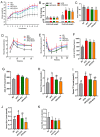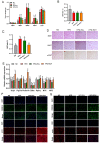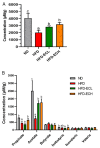Eurotium cristatum from Fu Brick Tea Promotes Adipose Thermogenesis by Boosting Colonic Akkermansia muciniphila in High-Fat-Fed Obese Mice
- PMID: 37893609
- PMCID: PMC10606327
- DOI: 10.3390/foods12203716
Eurotium cristatum from Fu Brick Tea Promotes Adipose Thermogenesis by Boosting Colonic Akkermansia muciniphila in High-Fat-Fed Obese Mice
Abstract
This study investigated the potential fat-thermogenic effects of Eurotium cristatum, and elucidated the underlying mechanisms. The 12-week administration of E. cristatum in HFD-fed obese mice reduced body weight and improved glucolipid metabolism disorders. The administration of E. cristatum also efficiently promoted thermogenesis by increasing the expression of UCP1 and PRDM16 in both interscapular brown adipose tissue (iBAT) and inguinal white adipose tissue (iWAT) of HFD-fed mice. Furthermore, E. cristatum shaped the gut microbiome by increasing the abundance of Parabacteroides and Akkermansia muciniphila, and also elevated the levels of cecal short-chain fatty acids, particularly propionate and acetate. Of note, A. muciniphila was highly negatively correlated with body weight gain (r = -0.801, p < 0.05) and the iWAT index (r = -0.977, p < 0.01), suggesting that A. muciniphila may play an important role in the thermogenic mobilization induced by E. cristatum. Continuous supplementation with A. muciniphila suppressed adipose accumulation, improved glucolipid metabolism, and enhanced the thermogenic activity of iWAT and iBAT. Collectively, our results propose that boosted A. muciniphila acts as a key microbe in tea-derived probiotic E. cristatum-mediated fat-thermogenic and anti-obesity effects.
Keywords: Akkermansia muciniphila; Eurotium cristatum; Fu brick tea; fat thermogenesis; gut microbiota.
Conflict of interest statement
The authors declare no competing financial interest.
Figures








Similar articles
-
Heimao tea polysaccharides ameliorate obesity by enhancing gut microbiota-dependent adipocytes thermogenesis in mice fed with high fat diet.Food Funct. 2022 Dec 13;13(24):13014-13027. doi: 10.1039/d2fo02415b. Food Funct. 2022. PMID: 36449351
-
Theabrownin from Fu Brick Tea Exhibits the Thermogenic Function of Adipocytes in High-Fat-Diet-Induced Obesity.J Agric Food Chem. 2021 Oct 13;69(40):11900-11911. doi: 10.1021/acs.jafc.1c04626. Epub 2021 Sep 28. J Agric Food Chem. 2021. PMID: 34581185
-
Eurotium cristatum reduces obesity by alleviating gut microbiota dysbiosis and modulating lipid and energy metabolism.J Sci Food Agric. 2022 Dec;102(15):7039-7051. doi: 10.1002/jsfa.12065. Epub 2022 Jul 6. J Sci Food Agric. 2022. PMID: 35690883
-
Eurotium cristatum, a potential probiotic fungus from Fuzhuan brick tea, alleviated obesity in mice by modulating gut microbiota.Food Funct. 2019 Aug 1;10(8):5032-5045. doi: 10.1039/c9fo00604d. Epub 2019 Jul 30. Food Funct. 2019. PMID: 31359019
-
Secondary Metabolites from the Genus Eurotium and Their Biological Activities.Foods. 2023 Dec 12;12(24):4452. doi: 10.3390/foods12244452. Foods. 2023. PMID: 38137256 Free PMC article. Review.
Cited by
-
Keys to the switch of fat burning: stimuli that trigger the uncoupling protein 1 (UCP1) activation in adipose tissue.Lipids Health Dis. 2024 Sep 28;23(1):322. doi: 10.1186/s12944-024-02300-z. Lipids Health Dis. 2024. PMID: 39342273 Free PMC article. Review.
-
Akkermansia muciniphila: A promising probiotic against inflammation and metabolic disorders.Virulence. 2024 Dec;15(1):2375555. doi: 10.1080/21505594.2024.2375555. Epub 2024 Aug 27. Virulence. 2024. PMID: 39192579 Free PMC article. Review.
-
Live Aspergillus cristatum from Fuzhuan Brick Tea Alleviates DSS-Induced Colitis by Intestinal Barrier Restoration and Suppressing NLRP3 Signaling Pathway Regulation.Foods. 2025 Feb 7;14(4):549. doi: 10.3390/foods14040549. Foods. 2025. PMID: 40001993 Free PMC article.
-
Quercetin activates energy expenditure to combat metabolic syndrome through modulating gut microbiota-bile acids crosstalk in mice.Gut Microbes. 2024 Jan-Dec;16(1):2390136. doi: 10.1080/19490976.2024.2390136. Epub 2024 Aug 20. Gut Microbes. 2024. PMID: 39163273 Free PMC article.
-
Genomic Characterization and Functional Evaluation of Eurotium cristatum EC-520: Impacts on Colon Barrier Integrity, Gut Microbiota, and Metabolite Profile in Rats.Foods. 2025 Apr 29;14(9):1569. doi: 10.3390/foods14091569. Foods. 2025. PMID: 40361651 Free PMC article.
References
-
- Xiao Y., He C., Chen Y., Huang Y., Gao Y., Hou A.Z., Li Y. UPLC-QQQ-MS/MS-based widely targeted metabolomic analysis reveals the effect of solid-state fermentation with Eurotium cristatum on the dynamic changes in the metabolite profile of dark tea. Food Chem. 2022;378:131999–132008. doi: 10.1016/j.foodchem.2021.131999. - DOI - PubMed
-
- Wang X.L., Liu X.X., Long B., Wei F.Y., Zhang J.P., Cui Y.X. Comparison of chemical constituents of Eurotium cristatum-mediated pure and mixed fermentation in summer-autumn tea. LWT-Food Sci. Technol. 2021;143:111132. doi: 10.1016/j.lwt.2021.111132. - DOI
Grants and funding
- 31871752/National Natural Science Foundation of China
- 32072175/National Natural Science Foundation of China
- 2020ZDLSF01-07/key research and development plan in Shaanxi province
- 2022QFY09-06/key research and development plan in Shaanxi province
- GK202101006/Development Program for Innovative Research Team of Shaanxi Normal University
LinkOut - more resources
Full Text Sources

